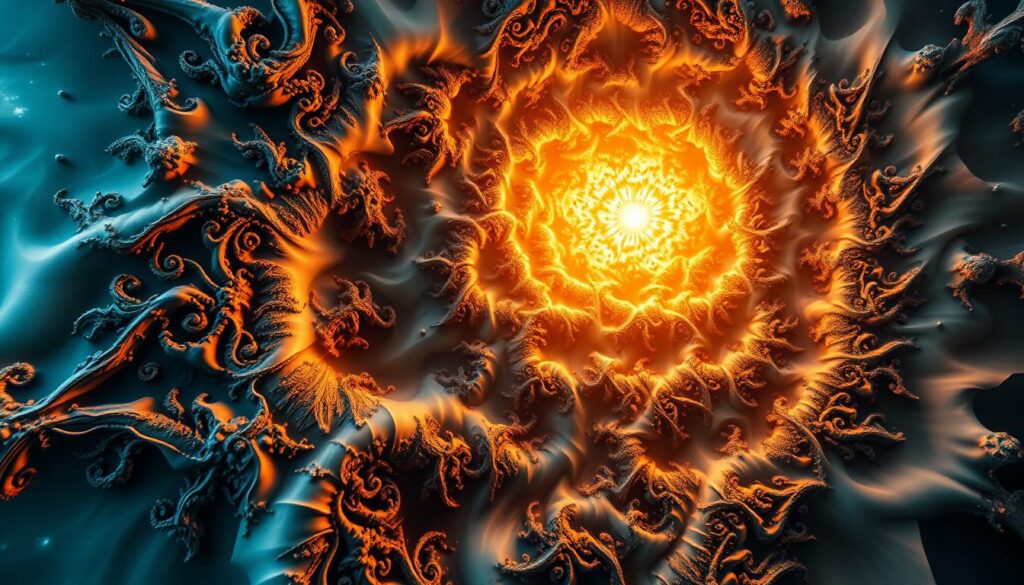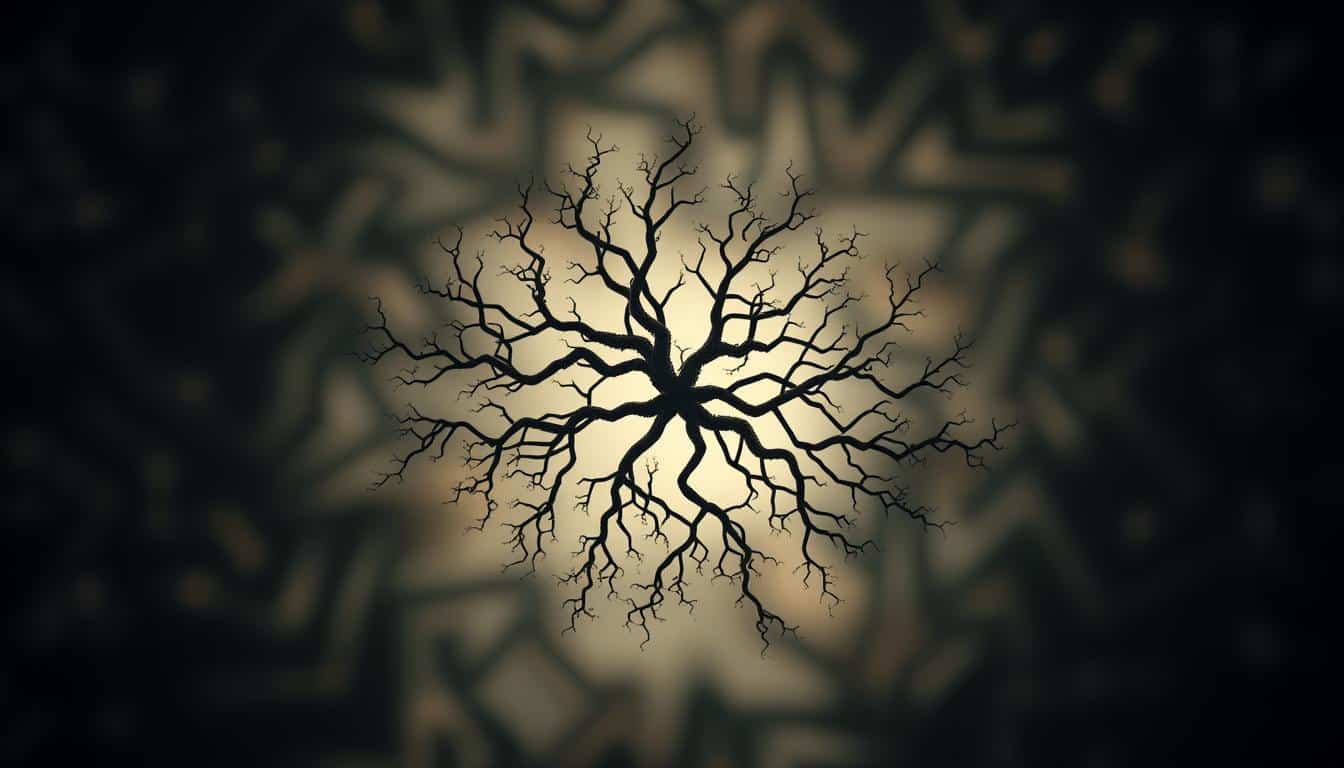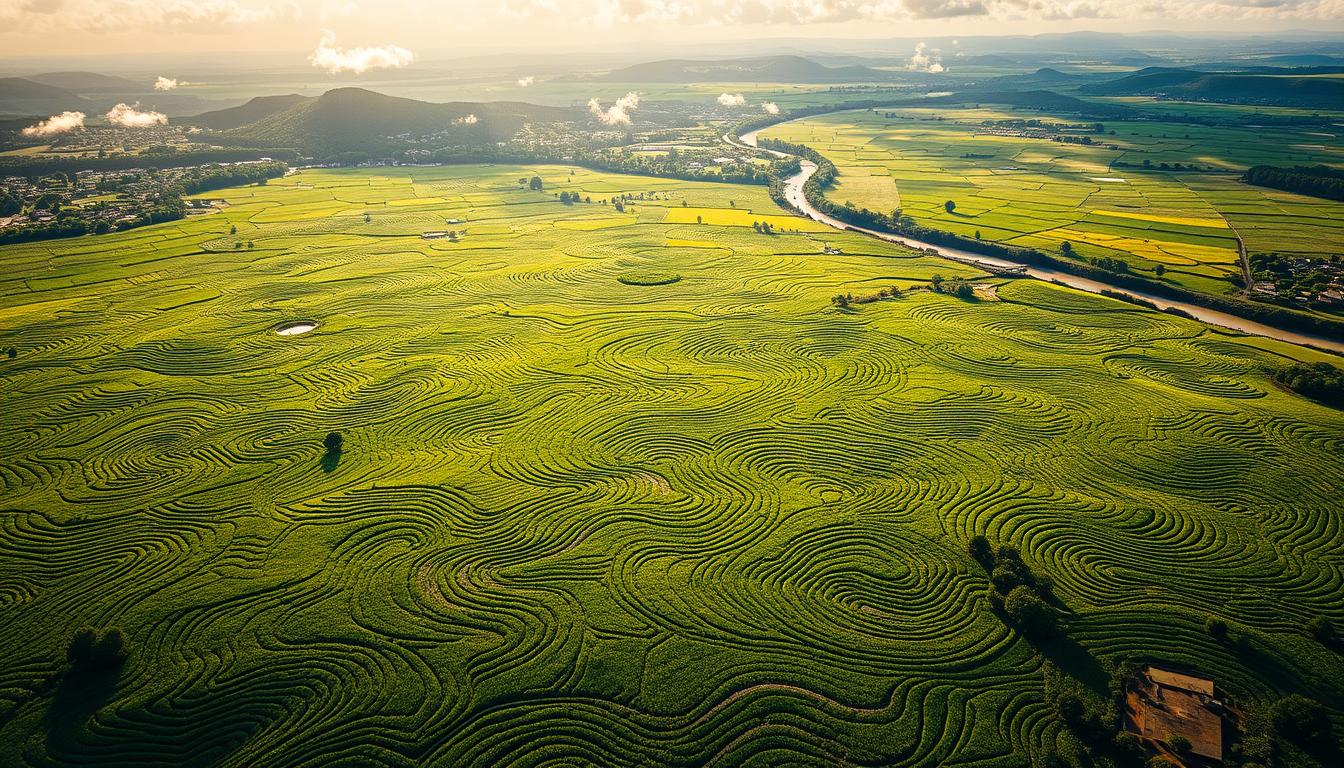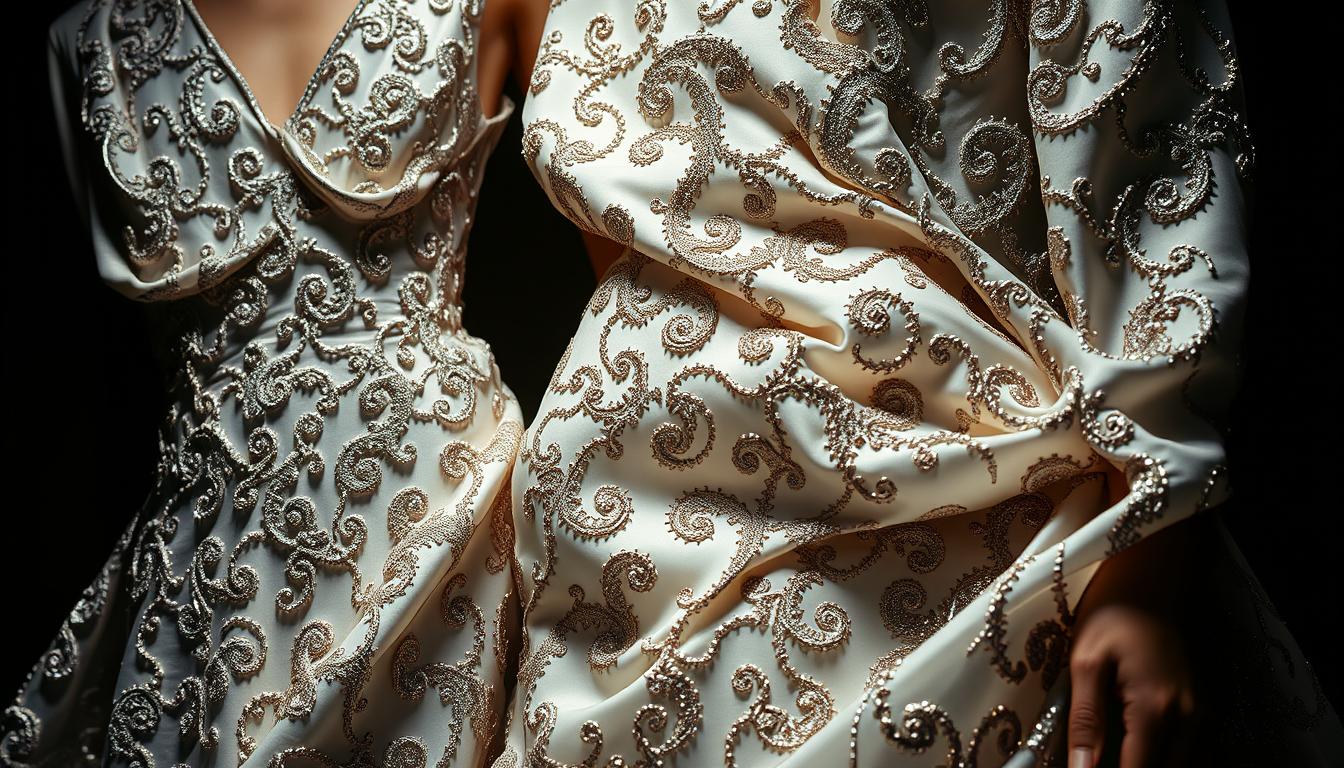Fractals mesmerize with patterns that repeat forever. They’re important in many indigenous cultures. These patterns are more than just beautiful. They show key parts of spiritual beliefs.
In native traditions, fractals show how everything in life is connected. They’re a symbol of spiritual importance. By looking at how indigenous groups use these patterns, we understand their rituals and deep beliefs better.
The Concept of Fractals: An Overview
Fractals blend math with art, showing us a different way to see nature. Benoit Mandelbrot, a mathematician, made them popular. He showed how complex forms are actually made of similar, simpler parts. A tree branch, for example, looks like the whole tree.
The Mandelbrot Set is a famous example of fractals. It shows complex designs coming from basic equations. When you look closer at the Mandelbrot Set, the same patterns keep appearing, no matter how much you zoom in.
Learning about fractals helps us understand their impact beyond just math. They show us new ways to view natural wonders like coastlines, clouds, and mountains. Fractals go against normal geometry by showing that even irregular shapes can have a pattern. This makes them important in science and art.

The Role of Geometry in Spiritual Traditions
Geometry has always been vital in spiritual traditions worldwide. It uses geometric symbols to express deep concepts like divine order. These symbols connect the cosmos and humanity in a way that goes beyond specific beliefs.
In different spiritual paths, geometry is not just shapes. It shows the universe’s basic structures. Circles mean unity, and triangles signify transformation and the link between us and the spiritual world. These symbols help followers understand their place in the universe.
Looking back in history, geometry’s role in spirituality is clear. Ancient people used geometric designs in their sacred sites and art to show their bond with the divine. These designs often aimed to solve the mysteries of life, merging the physical with the spiritual.
Studying geometry in spirituality leads to an intriguing mix of tangible and spiritual ideas. Through these symbols, people seek enlightenment. This pursuit deepens their spiritual understanding and respect for the divine order in life.
Fractals in Sacred Art and Architecture
Fractals and sacred art share a deep connection, blending geometry with spiritual beauty. Different traditions use fractals to show divine themes. They express the universe and higher realities through art.
Islamic Artistic Expressions of Fractals
Islamic Art showcases the beauty of fractal geometry. Its complex patterns shy away from figures, focusing on spiritual symbols instead. These motifs create a limitless feel, inviting deep thought on the divine.
Artists use patterns that mimic nature, placing Islamic Art as a key player in Sacred Art.
Hindu and Buddhist Mandalas as Fractal Designs
Mandalas in Hinduism and Buddhism act as spiritual guides, featuring fractal designs. They portray the cosmos and personal growth. These circles symbolize unity and completeness, helping in meditation.
Their layers mean different life aspects, blending Sacred Art with meditation smoothly.
Christian Cathedrals and Fractal Principles
Christian Cathedrals demonstrate fractal beauty, often using patterns like the Fibonacci sequence. Their design leads our gaze skyward, creating a spiritual vibe. These buildings prove Architecture can mirror divine beauty through exact forms and fractal ties.
Spiritual Significance of Fractals in Indigenous Cultures
Fractals have a deep spiritual meaning in indigenous cultures. They are connected to nature and the cosmos. Native American and African spirituality use these geometric patterns in art, stories, and rituals. They see fractals as signs of how everything in life is connected. Each part reflects a bigger universal truth.
Native American Perspectives on Fractal Patterns
Native Americans see fractals in many ways. You can find them in pottery designs and textile patterns. These designs often show landscapes, animals, and elements. Each layer has its own meaning. They teach about living in harmony with nature and life’s cycles. Many tribes think these patterns show the universe’s soul. They give insights into spiritual beliefs and practices.
African Spirituality and Fractal Motifs
In African Spirituality, fractals appear in art, dance, and rituals. They show the unity among people and the world. Fractals represent ties to ancestors and community identity, often seen in sculptures and textiles. These patterns have a spiritual meaning. They are thought to help guide through life’s challenges. African cultures show how their communities live in harmony with nature and the cosmos. They honor the unseen connections between all living things.
Mysticism and the Fractal Nature of Consciousness
Mysticism ties closely with the concept of fractals in our thinking. It shows us deep truths about what we go through. Spiritual moments often bring swirly patterns and complex shapes to mind. These shapes, like spirals, catch our attention. They show how everything is connected.
Looking into fractals helps us understand our own minds better. Spiritual activities like meditation help us see deep truths. People doing these activities find connections to the universe inside themselves. This shows how closely our inner thoughts and the outside world are linked.
This connection invites us to think deeply about our own experiences. Through this view, we see our consciousness as a wide and detailed network. It matches the universe’s complexity. Realizing this can make us curious about life’s reality. It shows us how spiritual moments shape how we see the world.
Psychedelic Experiences and Fractal Imagery
Psychedelic experiences are closely linked with shamanic traditions. They show how altered states of consciousness and fractal imagery intersect. Shamans from both ancient and modern times share deep experiences. In these, fractal patterns stand out, pointing to a deeper aspect of reality. This connection with fractal imagery is found in psychedelic trips worldwide. It highlights a common element in our human experience.
Shamanic Traditions and Fractal Experiences
Shamanic traditions value vision quests and ceremonies that bring about altered states. People often see fractal imagery during these times, showing how everything is connected. These experiences are described as:
- A sense of infinite patterns repeating and expanding.
- Colors and shapes changing into detailed designs that show nature’s beauty.
- Feeling time and space as flexible, offering peeks at other realities.
The strong link between psychedelic experiences and spiritual insights is evident. Fractal imagery in these experiences invites people to see beyond normal awareness. This highlights why shamanic practices are key to connecting us to the cosmos.
Fractals in Literature, Music, and Spiritual Storytelling
The study of fractals in literature and music uncovers an exciting blend of art and spirituality. Fractal designs weave intricate stories, inviting us to explore deeper meanings beyond the usual. As they unfold, these patterns enrich spiritual tales told across cultures.
Recursive Structures in Religious Texts
Recursive structures in religious writings mirror fractals seen in literature. These texts loop themes in ways that deepen reflection and understanding. Here are key elements readers will find:
- Motif Repetition: Key themes repeat, emphasizing the text’s messages.
- Layered Meanings: With each read, new insights emerge, similar to exploring a fractal.
- Interconnected Narratives: Stories intertwine, showing the interconnectedness of spiritual truths.
Fractal Patterns in Musical Traditions
Music uses fractal patterns to draw people into a shared, spiritual journey. These patterns connect with listeners, weaving together tunes and rhythms. Musical traditions reflect fractals through:
- Repetitive Themes: Recurring motifs in music echo these recursive structures.
- Layered Harmonies: Complex layers evolve from simple tunes, creating rich soundscapes.
- Dynamic Progressions: The unfolding of musical pieces resembles a spiritual quest.
The Spiritual Meaning of Fractal Patterns
Fractal patterns have a deep spiritual meaning in many cultures and beliefs. They show how everything in the universe is connected and united. When we see these patterns, we can understand the complexity of life. We also see how everything is linked together.
Unity and Interconnectedness in Spiritual Practices
In many spiritual traditions, unity and interconnectedness are key. Fractal patterns are a visual way to show these concepts. They reveal that everything in the universe is related. By exploring these patterns, people feel connected to something bigger than themselves.
To illustrate this spiritual meaning, consider the following:
- Fractals represent the continuous cycle of life and the link between all creatures.
- The repetitive aspect of fractal patterns echoes the cycles seen in nature and human life.
- Understanding these patterns can increase our awareness of life’s interconnected web, as taught in many spiritual paths.
Fractal patterns in spirituality guide us to a deeper understanding of life and the cosmos. They help us see the unity in the world. This insight encourages us to consider our role within this vast, interconnected network.
The Universe as a Fractal
The idea of the Universe as a Fractal Universe is fascinating. It suggests that the cosmos has repeating patterns, like fractals. These patterns show up on different scales across the universe.
Studies show that galaxies, star systems, and even asteroids look similar. This cosmic order supports the idea that the Universe follows fractal geometry rules. Seeing the Universe this way gives us insights into how everything is connected.
Nature, like trees and coastlines, also shows these patterns, similar to celestial bodies. This connection makes us feel united and links science with spirituality. It suggests that understanding the Fractal Universe can deepen our spiritual connections.
Fractals in the Natural World
Fractals are everywhere in nature, blending beauty with math. They appear in tree branches, river paths, and even in our bodies. These patterns show how math shapes our world.
In plants, we see fractals in leaf arrangements and sunflower spirals. This mix of chaos and order shows a hidden structure in what seems random. It’s fascinating!
Even the universe follows this fractal pattern. Galaxies form spirals similar to those found in nature. This shows that the same rules apply from the smallest details to the vast cosmos.
Understanding fractals helps us see nature in a new light. It’s not just about beauty – it’s a window into the universe’s rules. Looking at fractals, we feel closer to the mysteries of life.
Fractals: Connecting Science and Spirituality
Science and Spirituality often meet in the study of Fractal Geometry. This math reveals patterns not just in theory, but in real life too. These patterns show how simple rules can create complex designs, showing order in what seems chaotic.
In spirituality, fractals have a special meaning. They show a deep connection between different parts of reality. Spiritual beliefs about unity fit well with what science discovers through fractals. This shows us that Science and Spirituality are closer than we think.
Looking into fractals helps us understand consciousness and the universe. It brings together science and spirituality, showing they’re not at odds. Instead, they give us two perspectives on the mysteries of life.
Conclusion
Exploring fractals opens our eyes to how deeply they are woven into different spiritual beliefs, especially within indigenous cultures. Their complex patterns show us the beauty of existence, unity, and connection. Throughout time, many cultures have seen fractals as a way to understand nature and the divine.
Fractals are seen in sacred art, buildings, and spiritual practices, linking the physical world to the spiritual one. They capture the flow of life and the many layers of our minds. This link draws in those interested in spirituality and nature, inviting them to explore the patterns that fill our world.
Looking at fractals shows us they carry ancient knowledge. They urge us to learn more about their secrets, helping us see the beauty in existence. By learning about fractals, we can better appreciate the spiritual meaning they hold and honor the cultures that cherish them.



